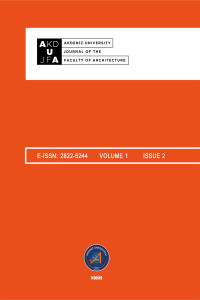Research Article
Aim & Scope
Akdeniz University Journal of the Faculty of Architecture is an international and open access academic journal which uses double blind peer-review process. The journal accepts submissions in English or Turkish. It is published biannually every July and December.
From the perspectives of architecture, planning and design, the objective of the journal is to provide an interdisciplinary sharing platform for contemporary knowledge and multidimensional analysis in the form of original academic research and review articles conducted within the context of built and natural environment.
Akdeniz University Journal of the Faculty of Architecture embraces the disciplines of architecture, interior architecture, city and regional planning, industrial design and landscape architecture and the interfaces produced by these disciplines with the fields of natural sciences, social sciences and fine arts.
The journal involves research in the disciplines of architecture, interior architecture, landscape architecture, city and regional planning and industrial design besides interdisciplinary research interpreting environment with respect to natural structure and productions of planning and design.
In this framework the journal accepts besides original academic research, review papers that have not been published previously or that are not under consideration for publication elsewhere.
Author Guidelines
AUTHOR GUIDELINES
The manuscript should be prepared 1,5 spaced with Times New Roman font size of 12 pt. on A4 size page. Margins on all sides should be 2,5 cm. Paragraphs should start with 1 cm indentation. There should be page numbers and line numbers in each line.
The originality and similarity rates of the study should be screened by iThenticate or Turnitin programs. This similarity report should be submitted as an attachment and the originality rates excluding the bibliography should be below 20%.
PAPER OUTLINE
1. COVER PAGE
2. TITLE, ABSTRACT AND KEYWORDS
3. MAIN TEXT
4. ACKNOWLEDGMENTS
5. BIBLIOGRAPHY / REFERENCES
Papers should be between 5 000 and 8 000 words including the captions of Figures and Tables and bibliography.
Each section of the paper should have the following content:
1. COVER PAGE
The cover page should include the title in Turkish and English (12 point), author names (10 point), addresses, orcid numbers (8 point).
The corresponding author should be stated with contact information.
2. TITLE, ABSTRACT AND KEYWORDS
Title: Papers should have short and precise titles, reflecting the topic and the content. Titles should not exceed 15 words with 12 pt. Times New Roman bold and capital letters.
Abstract: The abstract, which should not exceed 200 words, should explain the content, objective, method and conclusions of the paper. “Abstract” title should be Times New Roman in 10 point size while Abstract script must be single spaced with a font size of Times New Roman 8 point.
Keywords: The designation of 3 to 6 keywords related with the paper’s topic and content is essential. Please ensure that keywords are informative enough for literature scans. Keywords must be in Times New Roman, 8 point and italic.
3. MAIN TEXT
It is essential that the main text of the paper should have sections in order to convey the objective, content, research material, method, findings and conclusions. In case the paper conforms with natural sciences these sections may be “Introduction, Material and Method, Findings, Discussion and Conclusion”. Interdisciplinary studies within the scope of the journal may have different titles, whereas Introduction and Conclusion sections are required.
In any case the sections of the paper should cover the following contents: The “Introduction” section, which is mandatory, should interpret and emphasize the objective as well as the significance of the study within the framework of academic literature, the contribution of the study from the viewpoint of international literature should be stated clearly and the expected contributions should be shared. In this section authors should avoid the usage of figures or tables excluding explicitly essential examples regarding the topic.
In the following sections research material, criteria for the selection of the research material, the features and characteristics of the research material, method or methods, sample patterns and if necessary, statistical analysis should be presented clearly and accurately. In addition, when necessary, the findings of the study should be presented through clear and readable visual documents, original designs and statistical analyses. For this objective, captions can be used if necessary. Repetitions should be avoided and if visual information is used it should be given with original interpretations.
In the Discussion and Conclusion sections, original findings should be discussed, and conclusions should be emphasized in the light of existing academic literature, the significance of the study should be explicated by referring to figures, tables and analyses. Scientific, social, cultural and environmental contributions of the study should be stated.
The caption/titles in the main text of the article, should be Times New Roman, 12 point font size and bold. The use of single-numbered main captions/titles are required. When it is necessary, lower level of doubled-numbered and tripled-numbered captions/titles can be used.
The captions/titles and subdivisions within the paper should be as follows:
1. Single-numbered: Main Caption (Bold and Uppercase)
1.1. Double-numbered: Division (Bold and first letters Uppercase)
1.1.1. Triple-numbered: Subdivision (Regular and only first letters Uppercase)
No further subdivisions should be used
4. ACKNOWLEDGMENT
Researchers or other people who contribute to the manuscript and/or the study and the funding agency (project numbers, if any) must be specified.
5. REFERENCES / BIBLIOGRAPHY
All the sources/references used in the text should be cited according to the surname and year of the work, and should be shown in the text according to following examples.
References in the text:
- One author references: “……………... is observed (Atik, 2010).
- Two authors references: “……………...is identified (Parlak and Atik, 2020).
- Three and more authors: “……………...is emphasized (Parlak et al., 2013).
In case page numbers should be specified:
“……………... is observed (Atik, 2010, 17-19).
References made directly to the author within the text:
- According to Atik (2010)……………...developed.
- Parlak and Atik (2020) state that ……………..
- Atik et. Al. (2013) argue that ……………..
Same author and year, more than one reference (“a” should be used for the reference appearing in the text first and following letters should continue accordingly):
……………... (Atik et al. 2010a, 2010b)
More references in the same sentence:
Based on the publication year, starts with the earliest year of publication and continues according to the following years. For example “……………... demonstrated (Atik, 2010; Atik vd., 2013; Parlak and Atik, 2020).”
Bibliography/Reference List:
All references including books, articles, lectures, online documents, etc. are to be given in the bibliography/reference list in alphabetical order. References should be given in their original language. No abbreviations should be used. References list should be arranged in the first line is aligned to the left of the page, and the following lines begin with an indent of 1 cm.
Responsibility for incorrect citations belongs to the authors.
The format of the references should be as follows:
Papers in a journal:
Atik, M., 2010. Environmental Protection in Coastal Recreation Sites in Antalya-Turkey. Coastal Management 38 (6): 598 – 616. https://doi.org/10.1080/08920753.2010.519433
Atik, M., Bell, S., Erdoğan, R., 2013. Understanding Cultural Interfaces in the Landscape: a Case study of Ancient Lycia in the Turkish Mediterranean. Landscape Research 38 (2): 222-242. https://doi.org/10.1080/01426397.2011.642345
Books:
Makhzoumi, J.,Pungetti, G., 1999. Ecological Landscape Design and Planning. Taylor & Francis, p.352.
Article in an edited book:
Swaffield, S., 2005. Landscape as a Way of Knowing the World. In Harvey and Fieldhouse (Eds.), Cultured Landscape e designing the Environment in the 21st Century. Routledge, Taylor & Francis Group. ISBN 0-419-25030.
Institutional publications without specified authors:
TDK, 2005. Turkish Language Institution Turkish Dictionary. Turkish Language Institution 4th Evening Art School Press, Ankara, 2243 pages.
TUIK, 2005. Agricultural Structure. Turkish Prime Ministry State Institute of Statistics, Publication No: 1579, Ankara.
Internet References:
For any information, Figure and Table sources taken from the Internet, the following citations should be taken as a basis:
Antalya Governorship 2013. “Antalya with Turkish Institute of Statistics Data”. http://www.antalya.gov.tr/icerik/12/172/tuik-veriyle-antalya.html. (Accessed January 17, 2013).
NGBB 2021. Nezahat Gokyigit Botanical Garden History – Central Islands – Plan. Access http://www.ngbb.org.tr (Accessed 27.01.2021).
UNESCO, 2017. "Cultural Landscapes History and Terminology". http://whc.unesco.org/en/culturallandscape/#2 (Accessed 07.06.2018).
WHC 2012. Cultural Landscapes. UNESCO World Heritage Centre. http://whc.unesco.org/en/culturallandscape/ (Accessed 10.06.2012).
Wikiland, 2019. “A Glass House”. https://www.wikiwand.com/pt/Philip_Johnson (Accessed 21.12.2019).
Carder, J., “Philip Johnson and The Art Museum”. https://www.doaks.org/resources/philip-johnson/the-munson-williams-proctor-museum-of-art (Accessed 27.12.2019).
Pascucci, D., 2014. “AD Classics: Munson-Williams-Proctor Arts Institute/Philip Johnson”. https://www.archdaily.com/492133/ad-classics-munson-williams-proctor-arts-institute-philip-johnson/ (Accessed 25.12.2019).
Theses:
Kavas, K.R., 2009. Environmental Aesthetics of the Rural Architectural Tradition in the Mediterranean Highlander Settlement: the Case Study of Ürünlü. Middle East Technical University Graduate School of Social Sciences History of Architecture Program, Ankara, Turkey.
Article in Congress / Symposium Book (Full text):
Çelik, G., Kavas, K.R., 2012. A Case Study of the Local Builder’s Carpentry Tools: Traditional Constructions of Ürünlü, Turkey. 4th International Congress on Construction History, Paris, France 03-07 July 2012, pp. 506-519.
The name(s) of the author(s), the institution they are affiliated with, the city and country they live in, and their short curriculum vitae(s) should be written in 10 font size. Short resumes should not exceed 50 words. In multi-author articles, the author's CV should be prepared separately for each author. The e-mail address(es) of the author(s) should be added to the end of the resume.
FIGURES, TABLES AND CAPTIONS:
- The photographs, graphics, figures, schemes and etc. should be named as “Figure”, digital values should be named as “Table”.
- Figures and tables should be centered on the page.
- If the figures and tables are taken from another source necessary references should be given.
- All captions for the figures and tables should be 12 pt. Times New Roman.
- Captions should be short, succinct and informative.
- Captions of the Figures should be below the Figure, captions of the Tables should be above the table.
- Text in the Figures and Tables should not be larger than 8 pt.
- Dimensions of the Figures or Tables must be between 8 and 17 cm wide.
- In necessary cases, the maximum dimensions for Figures or Tables must be 16x22 cm.
- Photographs should be in JPEG, colored or grayscale with 300 dpi resolution. They should be informative with respect to the conclusions.
- Authors should control the printing qualities of the visual information they use, and they should prefer images appropriate for high quality printing.
- All figures and tables should be numbered according to the citation order and must be placed in the relevant section and must be given inside the main body of article text.
- If Figures and Tables are taken from another source, the Reference must be given in the Table title.
- No vertical lines should be used in the tables. For stating statistical significances P value should be given and the explanations for symbols like (*) should be done below the table.
- Lower case letters should be used for statistical comparisons and the selected method for comparison and its level of significance should be specified.
- If abbreviations are used in the figures or tables they should be explained right below the image.
- Figures composed of more than one component should be grouped and they should be converted to high quality JPEG format images.
ADDITIONAL EXPLANATIONS CONCERNING MEASUREMENT UNITS, ABBREVIATIONS, SYMBOLS, FORMULAE, EQUATIONS:
Units: SI (Système International d’Unités) unit system should be used. “/” should not be used and spacing should be left between units (eg.: not 5,6 kg/ha but instead 5,6 kg ha-1; not 18,9 g/cm3 but instead 18,9 g cm-3; not 1,8 µmol/s/m2 but instead 1,8 µmol s-1 m-2).
Abbreviations and symbols: No abbreviations should be used in titles. Necessary abbreviations should be given in brackets where the concept appears in the text for the first time. The abbreviations and symbols should conform to the universal rules of the related field of study.
Latin names and chemicals: The authority should not be used in the manuscript title. The authority should be given when the Latin names are first used in the abstract and the text, internationally accepted abbreviations should be used later. For example: "Pinus brutia (Ten.) is…”, “Pinus brutia ….grown in the…” " All Latin names should be written in italics, but the universal spelling rules of the relevant field should be followed in spelling and notation. The trade mark of chemicals used in the studies should not be given unless it is absolutely necessary to do so.
Formulas: Formulas should be named as “equations”. They should be numbered when necessary. The number should be indicated next to the formula between brackets. If possible, equations should be limited within one line.
Equations: Equations should be written based on the left of the page. Equations are numbered sequentially. These numbers should be written as (1), (2), (3) on the right side of the line. One line space should be left before and after the equations. Equations to be written in the text should be written left aligned with the equation editor in the Word writing program. When more than one equation is used, the equations should be numbered in parentheses, aligned to the right.
Ethical Principles and Publication Policy
Akdeniz University Journal of the Faculty of Architecture yayın etiği metninde yazarların, editörlerin ve hakemlerin etik sorumlulukları Committee on Publication Ethics (COPE) tarafından yayınlanmış olan kılavuzlar ve politikalar doğrultusunda belirlenmiştir.
Yazarların Etik Sorumlulukları:
• Yazarların gönderdikleri çalışmaların özgün olması beklenmektedir.
• Yazarların başka çalışmalardan yararlanmaları durumunda eksiksiz ve doğru bir biçimde atıfta bulunmalarıdır.
• Yazarların göndermiş oldukları çalışmaların başka bir yerde yayınlanmış ve aynı çalışmayla aynı anda birden fazla dergiye başvurulmamış olmalıdır.
• Çalışmaya herhangi bir katkı sağlamayan kişiler yazar olarak belirtilmemeli ve yazarların tümü yer aldıkları çalışma ile ilgili bilgi sahibi olmalıdır.
• Yayınlanmak üzere gönderilen tüm çalışmaların varsa çıkar çatışması teşkil edebilecek durumlar nedenleri ile birlikçe açıklanmalıdır.
• Çalışma bir tezden ya da projeden türetmişlerse, bu çalışmanın sonunda açıkça belirtilmelidir.
• Çalışmada kullanılan kaynaklardaki veriler objektif olarak yorumlanmalıdır.
• Yazarlar süreç içerisinde çalışmalarında bir hatayı fark etmesi durumunda düzeltme veya geri çekme gibi talepleri hakkında editörü veya yayıncıyı bilgilendirmelidir.
• Yazarlar kullanılan verilerin kullanım haklarına, etik kurul kararı gerektiren tüm nicel veya nitel yöntemlerle veri toplamayı gerektiren araştırmalar için gerekli izinleri aldıklarını ve deneklerin rızasının alındığını gösteren belgeye sahip olmalıdır.
• Etik kurul kararı gerektiren tüm araştırmalar için gerekli izinleri aldıklarına ve deneklerin rızasını aldıkların dair belgeye sahip olmalı ve etik kurul izni gerektiren çalışmalarda, gerekli izinlerin alındığına dair izinle ilgili bilgi makalede verilmelidir.
• Değerlendirme sürecinde olan çalışmalar için yazar ekleme, çıkarma, sırasını değiştirme gibi taleplerde bulunulmamalıdır.
Editörlerin Etik Görev ve Sorumlulukları:
• Editör, okuyucuların ve yazarların bilgi ihtiyaçlarını karşılamaya, derginin geliştirmeye ve iyileştirmeye, dergide yayımlanacak çalışmaların içeriğinin niteliğini ve kalitesini geliştirmeye yönelik çaba sarf etmelidir.
• Editör, yazarların düşünce özgürlüğünü desteklemeli, fikri mülkiyet haklarını korumalıdır.
• Editör, dergide yayınlanan içeriğin dergi yayın politikalarına uygun olmasını sağlamalı, insan ve hayvan haklarını ihlal etmediğinden ve gerekli etik kurul onaylarının alınmış olduğundan emin olmalı ve etik standartlardan taviz vermeden iş süreçlerini devam ettirmelidir.
• Editör, derginin yayım ve yazım kuralları, hakem değerlendirme süreçleri ile ilgili bilgilerin güncel ve erişilebilir olduğundan emin olmalıdır.
• Editörün, bir makaleyi kabul etme ya da reddetmede ölçütleri önemi, orijinalliği, açıklığı ve derginin ilgi alanına girip girmediği olmalıdır,
• Akademik açıdan bütünlüğü sağlanma,
• Düzeltme, açıklama gerektiren konularda yayın açısından açıklık ve şeffaflık gösterme.
• Editör, ön değerlendirme sürecinde reddedilen bir makalenin neden reddedildiğini yazara açıklamakla yükümlüdür,
• Editör, makaleler için bilgi ve uzmanlıkları doğrultusunda uygun hakemlerin seçilmesini sağlamalı ve çıkar çatışması olabilecek durumlara yol açmamaya özen göstermelidir.
• Çift taraflı kör hakemlik değerlendirme sürecinin uygulanmasından sorumlu olan editör, hem hakemlerin hem de yazarların kimlik bilgilerini gizli tutmalıdır,
• Editör, hakem listelerini uzmanlık alanlarına göre sürekli yenileyerek hakem veri tabanını mümkün olduğunca genişletmeye çalışmalıdır,
• Editör, hakemlerden beklentilerini açıkça ifade etmeli, hakemlerin değerlendirme formlarının açık ve anlaşılır olduğundan emin olmalıdır,
• Editör, hakemlerden gelen değerlendirmelerin zamanında, bilimsel ve etik kurallar çerçevesinde, yansız bir şekilde yapılmış olduğundan emin olmalıdır ve bu doğrultuda değerlendirme yapmayan hakemleri veri tabanından çıkarmalıdır,
• Editör, ön değerlendirme ya da hakem değerlendirme süreci sonunda makalede talep edilen değişiklikleri yazarlara zamanında bildirmek, düzeltme için gerekli süreyi onlara tanımakla yükümlüdür,
• Editör, yazarların sürece dair bilgi talebinde bulunmaları durumunda, çift taraflı kör hakemliği ihlal etmeyecek şekilde bilgi vermelidir,
• Editör, yayın kurulu üyelerini derginin gelişimine aktif katkı sağlama ölçütüne göre belirlemeli ve düzenli olarak toplantı yapmalıdır,
• Editör, yayın kurulu üyelerinin yapacakları değerlendirmeler için uzmanlık alanlarını göz önünde bulundurur,
• Editör, dergi içeriğine dair eleştirileri dikkate almalı ve yapıcı bir şekilde yaklaşmalıdır, eleştirilen makale yazarlarına cevap hakkı tanımalıdır,
• Editör, olası şikâyetleri nesnel bir açıdan değerlendirmeli, aydınlatıcı ve açık bir şekilde cevaplamalıdır,
• Editör, her makalenin kayıtlarını ve ilgili yazışmalarını elektronik ortamda saklamalıdır.
Hakemlerin Etik Sorumlulukları:
Hakemlerin etik sorunluluklarının hazırlanmasında COPE Ethical Guidelines for Peer Reviewers kılavuzundan yararlanılmıştır.
• Hakem, uzmanlık alanına ilişkin çalışmalar için hakem olmayı kabul etmeli ve değerlendirmeyi kendi yapmalıdır.
• Tarafsızlık ve gizlilik ilkeleri kapsamında değerlendirme yapan hakem herhangi bir çıkar çatışması olduğunu fark ettiğinde editöre bildirmelidir.
• Hakem, gizlilik ilkesi gereği değerlendirmekte olduğu makale yayınlanana kadar çalışmanın gizliliğinden sorumludur.
• Hakem, nesnel bir şekilde ve yalnızca makalenin içeriğini göz önünde bulundurarak yaptığı değerlendirmeyi değerlendirme formunda kendisinden istenen verileri eksiksiz doldurarak dergiye iletmelidir.
• Hakem, değerlendirmelerinin nedenlerini açıklayıcı ve ikna edici bir şekilde belirtmelidir.
• Hakem, değerlendirmelerini, düzeltmelerini ve önerilerini akademik, nazik ve yapıcı bir dille yapmalı, kişisel yorumlardan, hakaret ve kaba bir üsluptan kaçınmalıdır.
• Değerlendirme yapmayı kabul eden hakem, kendisine verilen süre içinde ve etik sorumluluklar doğrultusunda hakem değerlendirme raporunu hazırlamakla yükümlüdür.
Etik Dışı Davranışlar:
Belirlenen ilkeler doğrultusunda, etik ilkelere uygun olmayan bir çalışma tespit edildiğinde e-posta yoluyla bildirilecektir. Bu kapsamda;
• Editörler; çalışmada insan ve hayvan haklarının korunmasını amacıyla etik kurul onayı istemekle sorumludur. Bulunmaması durumunda red edebilir.
• Editörler; yayınlanan makalelerin fikri mülkiyet hakkını korumakla ve İçeriklerin başka yayınların fikri mülkiyet haklarını ihlal etmemesi konusunda sorumludur.
• Yayın Etiği başlığında sunulan Etik ilke ve sorumluluklar çerçevesinde yazarlar bölümüne uymalıdır. İlk olarak gönderilen makaleler iThenticate® (Plagiarism Detection Software) (veya Turnitin programı ile benzerlik raporları için kontrol edilmekte ve makalelerde en fazla %20'den fazla benzerlik oranı aranmaktadır.
Kişisel verilerin korunması:
Editörler; çalışmalarda ele alınan kişisel verilerin korunmasını sağlamakla yükümlü olup bireylerin açık rızası belgeli olmadığı sürece çalışmayı red edebilmektedir. Ayrıca editörler; yazar, hakem ve okuyucuların bireysel verilerini de korumakla yükümlüdür.
Dergi sahibi ve yayıncı ile ilişkiler:
Editörler ve yayıncı arasındaki ilişki editöryal bağımsızlık ilkesine göre, editörlerin alacağı tüm kararlar yayıncı ve dergi sahibinden bağımsızdır. Ayrıca yayıncı yayınlanmış her makalenin mülkiyet ve telif hakkını korumaya ve her kopyanın kaydını saklamaya özen göstermelidir.
Ücret Almama Politikası:
Akdeniz University Journal of the Faculty of Architecture açık erişim dergisidir ve işleme ücretleri (APC) ve makale yayın ücreti (ASC) talep etmez. Derginin içeriğine herhangi bir ücret ödemeden çevrimiçi olarak erişilebilir.
Çıkar çatışmaları:
Editörler; yazar(lar), hakemler ve diğer editörler arasındaki çıkar çatışmalarını düşünülerek yayın sürecinin bağımsız ve tarafsız bir şekilde tamamlamasını garanti eder.
Price Policy
Journal has no publishing charge.
Indexes
Journal Boards
Editör Yardımcısı

Editörler Kurulu

Professor of Architecture at Akdeniz University Faculty of Architecture, Department of Architecture. Kavas received his B.Arch and M.Arch degrees in Architecture from METU (Middle East Technical University, Ankara, TURKEY) in 2002 and 2005 and his Ph.D. degree in Architectural History from METU in 2009. His Ph.D. thesis conceming environmental aesthetics of the rural highlander settlements of the Anatolian Mediterranean has won the 2009 METU Thesis of the Year award. His major research interests include rural architectural traditions, environmental & urban aesthetics, architectural history & theory and freehand drawings.

Dilek KOC SAN received her bachelor’s degree from Gazi University, Faculty of Engineering and Architecture, Department of City and Regional Planning in 2000. In 2009, she received her Doctorate degree from Middle East Technical University, Department of Geodetic and Geographic Information technologies. During her doctorate education, she conducted research for 6 months in 2006 at the Swiss Federal Institute of Technology (ETH), Department of Photogrammetry and Remote Sensing. She worked as a Research Assistant at the Middle East Technical University, Graduate School of Natural and Applied Sciences, Department of Geodesy and Geographical Information Technologies between 2002-2009 and as a Research Assistant Dr. at Selcuk University, Graduate School of Natural and Applied Sciences, Department of City and Regional Planning between 2009-2011. In 2011, she was appointed as an Assistant Professor at Akdeniz University, Faculty of Science, Department of Space Sciences and Technologies. In 2014, she received the title of Associate Professor in the field of City and Regional Planning. Since 2017, she has been working as a faculty member at Akdeniz University, Faculty of Architecture, Department of City and Regional Planning, Department of Planning Technologies. She was received Professor title in 2020.

Nowadays, I am working on economic resilience in crisis cities and factors defining firm survival strategies in crisis. This project was funded and awarded by The Science Academy (https://en.bilimakademisi.org/the-science-academy-why/) in Turkey as the first project awarded in the field of urban and regional science. I was also awarded as a Outstanding Young Scientist Award given by Turkish Academy of Sciences (TÜBA). With the support of TÜBA, I worked on future fictional expectations of (tourism) cities experiencing both economic, natural and political crisis. Nowadays, I am working on future fiction for cities.

Graduated from the Department of Architecture, Faculty of Architecture, Istanbul Technical University, in 2000. In the same year, she began a master’s degree in the Building Construction Management Program at Istanbul Technical University’s Department of Architecture. She completed a thesis titled "Contract Characteristics in Construction Management-Type Project Delivery Systems (Case Study: USA) and the Roles of the Construction Manager" in 2002, earning a master’s degree.
Between 2007 and 2013, she pursued doctoral studies in the Building Sciences Program at Istanbul Technical University’s Graduate School of Science, Engineering, and Technology. She successfully completed a doctoral dissertation titled "The Construction Management Model as a Project Delivery Method in Public Tenders in Turkey."
From 2005 to 2010, she worked as a lecturer in the Restoration Program at Serik Gülsün-Süleyman Süral Vocational School, Akdeniz University. Between 2010 and 2013, she served as a lecturer in the Department of Architecture at the same university, and since 2013, she has been a faculty member in this department. She was awarded the title of Associate Professor in the field of Architecture in 2018 and was promoted to the rank of Professor in 2024.
Her primary areas of expertise include project and construction management, occupational safety, construction site management, and fire safety.


Emrah YILDIRIM is an Assistant Professor and a full time lecturer at Akdeniz University, Faculty of Architecture, Department of Landscape Architecture in Antalya, Turkey. He received master’s degree in 2004 and doctoral degree in 2013 while he was working as a research assistant in the same university between the years 2001-2017. At the same period he also worked as a researcher on many national projects. His works focuses on landscape planning, landscape metrics. Currently, he carries out studies on energy landscapes.

Dr Vladimir Mako, is the professor at the University of Belgrade – Faculty of Architecture and University of Donja Gorica – Faculty of Polytechnics.He is also the president of the Serbian Association for Aesthetics in Architecture and Visual Arts.
He is author of a number of books, articles, and conference papers, including:
An Islamic Numerical Interpretation of Hagia Sophia in Constantinople, Keynote Speach, Proceedings of the 21th International Aesthetic Conference ‘Possible Worlds of Contemporary Aesthetics: Aesthetics Between History, Geography and Media’, University of Belgrade – Faculty of Architecture, Belgrade 2019, pp. 32-44; The Aesthetics and Attainability of Cultural Cohesion: The Metaphorical Compositional Structure of “Oresteia” and Acropolis of Athens, Athens Journal of Architecture, vol.5, issue 1, January 2019, Athens Institute for Education and Research, Athens, pp.99-110; Lorenz Stoer and the Metaphor of Creative Power in Architecture, Athens Journal of Architecture, vol.4, issue 1, January 2018, Athens Institute for Education and Research, Athens, pp.65-84; The Aesthetics of Transformation, Athens Journal of Architecture, vol.3, issue 3, The Athens Institute for Education and Research, Athens (2017), pp.263-276; Ideology and Architecture: Aesthetic Rationalism and its Cultural Response, In: Architecture and Ideology, ed. Vladimir Mako, Mirjana Roter Blagojević, Marta Vukotić Lazar, Cambridge Scholars Publishing, Newcastle upon Tyne 2014, pp.13-26; Aesthetic Thoughts on Architecture: Middle Ages, Faculty of Architecture University of Belgrade, Belgrade 2012.; Aesthetic Thoughts on Architecture: Antiquity, Faculty of Architecture, University of Belgrade, Belgrade 2011.

Yayın Editörü

Sekreterya

İngilizce Dil Editörü
Türkçe Dil Editörü

.....
Danışma Kurulu
Prof. Dr. Ali Uzay Peker, Orta Doğu Teknik Üniversitesi, Mimarlık Tarihi Lisansüstü Programı'nda Profesör olarak çalışmaktadır. Selçuklu ve Osmanlı Mimarisi ile ortaçağ kozmolojisi üzerine dersler vermektedir. Çok sayıda ulusal ve uluslararası dergide yayınlanmış makaleleri ve editörlüğünü yaptığı kitapları bulunan bir sanat ve mimarlık tarihçisidir. Türkiye'de ortaçağ mimarisinde sembolizm üzerine yaptığı araştırmalarla İslâmî dönemde, ortaçağ Anadolu'sundaki mimari sembollerin anlamlarını ortaya koymuştur. Ayrıca İstanbul'daki Nur-u Osmaniye gibi on sekizinci yüzyıl yapılarını inceleyerek yayımlamıştır. Zigetvar Sultan Süleyman Türbesi arkeolojik kazısında koordinatör olarak görev yapmıştır. İstanbul Teknik Üniversitesi'nden Sanat Tarihi alanında doktora, Boğaziçi Üniversitesi'nden Tarih alanında yüksek lisans ve İstanbul Üniversitesi'nden sanat tarihi alanında lisans derecesi almıştır. Ali Uzay Peker, Türk Tarih Kurumu Bilim Kurulu üyesi, çeşitli akademik dergilerde bilim ve yayın kurulu üyesi, deneyimli bir eğitimci, yönetici ve proje koordinatörü, Marie Curie proje hakemi ve Bologna uzmanıdır.
Prof. Dr. E.Füsun Alioğlu
İstanbul Devlet Mühendislik ve Mimarlık Akademisi (İDMMA), Mimarlık Bölümü’nden 1978 yılında mezun oldu. Aynı kurumda, Rölöve Restorasyon Dalı’nda 1981 yılında “İmrahor İlyas Bey Camisi -St. John Stoudios Manastır ve Kilisesi- Tarihsel Gelişim ve Çağdaş Biçimleniş Önerisi” adlı tez ile yüksek lisans eğitimini tamamladı. İTÜ Fen Bilimleri Enstitüsü, Mimarlık Tarihi Anabilim Dalı’nda, 1989 yılında tamamladığı “Geleneksel Mardin Şehir Dokusu ve Evleri Üzerine Bir Deneme” başlıklı teziyle doktor unvanı aldı. Akademik kariyerine 1982 yılında, İDMMA, Kadıköy Mühendislik ve Mimarlık Fakültesi’nde asistan olarak başladı. 1982 yılında, Yıldız Üniversitesi, Mimarlık Fakültesi Restorasyon Anabilim Dalı, Tarihi Çevre Değerlendirme Bilim Dalı’nda Araştırma Görevlisi oldu. 1990-1993 yılları arasında Yrd. Doç. 1993 – 2001 yılları arasında Doçent olarak görev yaptı. 2001 yılında Profesör oldu. 2003-2007 yıllarında, YTÜ Mimarlık Fakültesi, Mimarlık Bölümü Başkanlığı; 2007-2008 yıllarında Restorasyon Anabilim Dalı Başkanlığı yaptı. Şubat 2008’de Kadir Has Üniversitesi, Güzel Sanatlar Fakültesi, İç Mimarlık ve Çevre Tasarımı Bölümü öğretim üyesi oldu. Halen aynı üniversitenin Sanat Tasarım Fakultesi, Mimarlık Bölümü öğretim üyesi; Lisansüstü Eğitimi Enstitüsü, Kültür Varlıklarını Koruma Yüksek Lisans ve Doktora Programı yürütücüsü olarak görev yapmaktadır. Mimarlık tarihi, kültürel mirasın korunması, mimarlık eğitimi, mimarlık mesleği konularında ulusal ve uluslararası makale, bildiri ve yayınları bulunmaktadır.
Prof. Dr. Neslihan Dostoğlu, 1973 yılında Robert Kolej’den, 1978’de O.D.T.Ü. Mimarlık Bölümü’nden mezun oldu. Aynı Bölüm’de yüksek lisans derecesini aldıktan sonra eğitimini sürdürmek üzere A.B.D.’ye gitti ve 1986’da mimarlık alanında doktorasını tamamladı.
Türkiye’ye döndükten sonra 1988-1990 yılları arasında Anadolu Üniversitesi’nde, 1994 yılından sonra da Uludağ Üniversitesi Mimarlık Bölümü’nde akademik kariyerine devam etti. 1997 yılında doçent, 2003 yılında profesör ünvanını alan Dostoğlu, Uludağ Üniversitesi’nde onaltı yıl görev yaptı. Ayrıca, 1998-2008 yılları arasında Bursa Kültür ve Tabiat Varlıklarını Koruma Kurulu üyesi ve başkanı oldu.
2010 yılında İstanbul Kültür Üniversitesi Mimarlık Bölümü akademik kadrosuna katılan ve halen İstanbul Kültür Üniversitesi Mimarlık Fakültesi Dekanı olan Dostoğlu, 2019-2021 döneminde Mimarlık Fakültesi Dekanları Konseyi (MİDEKON) Dönem Başkanı olarak görev yaptı. Dostoğlu, ayrıca Bursa’nın UNESCO Dünya Miras Listesi’ne adaylık sürecinde 2011 yılında Alan Başkanı olarak atandı ve Bursa’nın 2014 yılında UNESCO Dünya Miras Listesi’nde yer almasında önemli rol oynadı.
Dostoğlu’nun yurtiçinde ve yurtdışında yayımlanmış kitapları, kitap editörlükleri, kitap bölümleri, önemli dergilerde yayımlanmış makaleleri, kongre bildirileri ile çeşitli mimari proje yarışmalarında ve meslekte başarı ödülleri bulunmaktadır.

Kağan Günçe is Professor of Architecture at Eastern Mediterranean University (EMU) in North Cyprus. He is a full-time professor in the Department of Interior Architecture, EMU. He also serves as Vice-Chair of the Institute of Graduate Studies and Research at EMU. He has a Bachelor degree in Architectural Program, a Master (of Science) degree in Architecture Program and Ph.D. in Architectural Theory from EMU, Department of Architecture. He was the director of HERA-C (Housing Education, Research & Advisory Centre) and he was the head of the Interior Architecture Department at EMU. He was a long-time University senator and is currently the elected professor representative senator. His research interests include architectural theory, design, environmental psychology, conservation, housing issues and childhood space. He has also collaborated with researchers in several other disciplines such as role of technology in shaping memory of architectural space / topics in profession and education of interior architecture. He has articles, papers in many national and international journals & conferences, and international research projects in the mentioned fields. His academic work has received many citations in web of science platform.
https://www.webofscience.com/wos/woscc/summary/cd41b734-ba5a-4ea6-a2e7-d9e754905485-4ec8121e/relevance/1

Dr. Sedef Doganer studies design issues related to tourist spaces, resort towns, sustainable tourism development, and is an expert on cultural heritage tourism. Her research focuses on hotel design, sustainable tourism alternatives, tourism destination planning, and touristic places. She specializes in innovative, multi-disciplinary research on development in heritage zones that respects the continuity of existing heritage. Dr. Doganer’s work is widely recognized nationally and internationally. She has gained substantial experience in planning rural areas and villages towards Sustainable Rural Tourism in Turkey and is honored to be awarded by The Turkish Tourism Investors Association (TTYD) with a Barlas Kuntay Tourism Research Award in 2006 for her work "Life in Unulla Village." She has also been involved in "Master Planning Services for HemisFair and Surrounding Area" and served as one of the Historic Preservation Strategists (Co-PI) in 2010. Doganer is currently a member of the ICOMOS International Cultural Tourism Committee.
Her most recent projects include an assessment of San Antonio’s heritage resources, an analysis of heritage tourism small-business potential near Missions San José and San Juan, and research on heritage travelers. In light of the Missions’ recent designation as a UNESCO World Heritage Site, such detailed data will aid the city in promoting cultural travel, developing marketing campaigns around the travel trend, and supporting viable local businesses that are attractive to heritage tourists and locals alike.
Before she moved to the U.S., Dr. Doganer received many design awards with her practice in Turkey. She served as project manager and principal designer for numerous building design projects throughout Antalya and Istanbul. Dr. Doganer received her Bachelor of Architecture, Master of Science in Architecture, and Ph.D. from Istanbul Technical University.
At Wentworth Institute of Technology she teaches graduate and undergraduate design studios in addition to courses about architecture and tourism. She currently serves as the Dean of School of Architecture and Design at Wentworth Institute of Technology.
 Web
Web
Antonella Contin, architect and Ph.D., is a researcher at DAStU, Department of Architecture and Urban Studies, within the School of Architecture, Urban Planning, and Construction Engineering at Politecnico di Milano. She coordinates MSLab: Measure and Scale of the Contemporary City and MetroHUB, the UN-Habitat Centre on Metropolitan Dynamics, and is involved in the Politecnico di Milano initiative. She is the scientific coordinator and organiser of international workshops and seminars and leads several EU-funded research projects, including TEllme, Contested Territories, and Smart. With a regular presence at numerous international universities, her research centres on metropolitan architecture projects, urban growth, sustainable models, intelligent and responsive cities, new technologies, and urban mapping.

 Web
Web
https://orcid.org/0000-0002-7714-3363
Associated Professor in the Urban Design and Regional Planning Unit at the University of Alicante. Each research covers different topics including landscape planning for territorial and urban space analysis. Her main research field is landscapes of the Spanish Mediterranean Arc. She has also participated in several research projects related to the use of location-based social network data for evaluating city planning in collaboration with the MappingAME Research Laboratory of the University of Alicante.
Her research activity is developed through two lines of research that have as a common framework for the landscape and its perception, both at the territorial and urban scale, supported by 6 I+D+i competitive projects -1 as IP and the rest as a member of the research team-: (L1) the urban-territorial landscape and its perception: spatial organization, urban regeneration and the transformation of the collective image. This L1 is related to 3 research projects: a) Progr.PropioUA, IP researcher GRE21-06A "[GreenWedgeConnectivity] Peri-urban transects: Valorization of green infrastructure as an ecosystem service" (2022-2024); b) PID2020-116893RB-100 "[PER-START]Peri-Urban strategic areas in transformation" (2021-2024) national competitive project team member; c) project GRE05-09 "Urbanism in the coastal strip of the province of Alicante: analysis and diagnosis", of Prog. (L2) subject: "Landscape, perception, and monitoring of urban dynamics through data from social networks or application of technology". Linked to 4 research projects: 1-GV-(2017-2019) AICO/2017/018 "The cities of the Valencian Community through geolocated data"; 2-Progr.PropioUA(2019-2021) "GRE18-19- LIVELYCITY- Interdisciplinary methodologies for the study of the city from geolocated social networks"; 3- Progr.PropioUA(2016-2018) "GRE15-14- MAPPINGAME- Representation and interpretation of urban dynamics through geolocalized data from social networks and web services"; 4)Prog.PropioUA- IP "GRE21-06A [GreenWedgeConnectivity] (2022-2024). The
scientific production developed is supported by papers published in WOS - SCOPUS -AVERY journals and book chapters in SPI editorials.
These works contribute to the advancement of knowledge and innovation through the design and testing of methodologies that provide an effective tool for application to urban planning. This facilitates the analysis of urban clusters of tourist activity, green infrastructure, or coastal spaces at a fine granularity scale of detail. Furthermore, the relevance of the research is reflected in its contribution to SDG 11. The selected papers demonstrate the dynamics of different urban and periurban scales, based on actual user activity, preferences, and geo-referenced digital traces. This makes it possible to conduct an opportunity analysis for urban planning that complements other traditional tools.
In the transfer, technological development, and innovation activities, there has been collaboration with public or private entities in agreements or contracts. Among these, some are of particular significance in the improvement of urban and peri-urban environments of tourist interest.
Özlem Er (Ankara, 1966) lisans ve yüksek lisans derecelerini (BID, MSc) Orta Doğu Teknik Üniversitesi’nden, doktora derecesini ise Manchester Metropolitan University, İngiltere’den aldı. ODTÜ Endüstri Ürünleri Tasarımı Bölümü’nde (1996 -2000) ve İTÜ Endüstri Ürünleri Tasarımı Bölümü’nde (2000 – 2018) öğretim üyesi olarak çalıştıktan sonra, halen İstanbul Bilgi Üniversitesi Endüstri Ürünleri Tasarımı Bölümü’nde tam zamanlı öğretim üyesi ve 2019 yılından bu yana da bölüm başkanı olarak görev yapmaktadır. Akademik çalışmalarının yanısıra endüstriyel tasarımın tanıtımında aktif rol oynadı ve Endüstriyel Tasarımcılar Meslek Kuruluşu merkez ve Istanbul Şube yönetim kurullarında (ETMK, kuruluş 1988) genel sekreter, başkan yardımcısı ve başkan olarak görevler üstlendi. ETMK İstanbul Şube Başkanı olarak Design Turkey Endüstriyel Tasarım Ödülleri’nin 2012 ve 2014’teki organizasyonunu gerçekleştiren ekipte aktif olarak yer aldı ve bu etkinlikler kapsamında yer alan iki konferansı düzenledi. Tasarım yönetimi eğitimi alanında lisans ve lisansüstü düzeyde eğitimi başlattı ve gerek bu alanda ve gerekse de tasarım alanında farklı konularda yüksek lisans ve doktora çalışmaları yönetti. 2012 yılında İSTKA desteği ile yeni mezun tasarımcılarla, yeni ürün geliştirme ihtiyacı içindeki KOBİ’leri internet üzerinde kayıt olunarak erişim sağlanan bir sistem ile eşleştirmeyi amaçlayan kısaca KOBİ’ler İçin Tasarım olarak tanımlanan projenin yürütücülüğünü üstlendi. Özlem Er, European Academy of Design (EAD) Yönetim Kurulu üyesi olmanın yanısıra, Royal Society of Arts üyesi (Fellow of the RSA) ve The Design Journal dergisi Editörler Kurulu üyesidir ve çalışma alanlarında ulusal ve uluslararası düzeyde birçok yayını bulunmaktadır.

Editör in Chief
Associate Editor
Secretariate
Publication Editor
Layout Editor
English Language Editor
Turkish Language Editor
Editorial Board

Advisory Board




